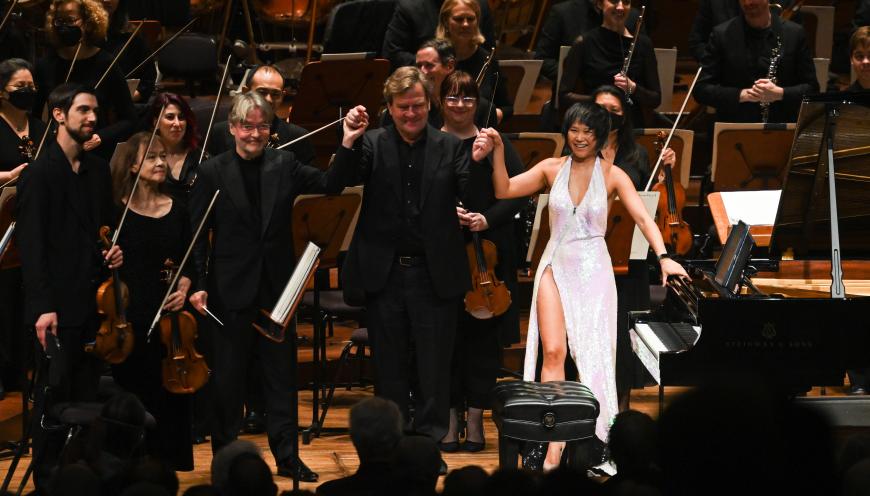
The piano concerto by Magnus Lindberg that received its first performance at Davies Symphony Hall on Thursday, Oct. 13 was his third. Yuja Wang, for whom it was written, was the soloist. The San Francisco Symphony was conducted by Music Director Esa-Pekka Salonen, who has been a friend of Lindberg’s since they met as teenagers at music school in Finland.
It’s impressive, though hardly unprecedented, that Lindberg has piled up this many piano concertos. Davies audiences heard his then-new Second Piano Concerto 10 years ago from Yefim Bronfman when the New York Philharmonic paid a visit. That work marked an evolution in Lindberg’s style, from a harsh modernism into something that, as SF Classical Voice’s reviewer put it, “looks back fondly to early 20th-century Romanticism.” Soon afterward, Lindberg’s Clarinet Concerto was at the Cabrillo Festival, where its solo part was repurposed by Emil Jonason from strenuous grotesquery into sweet gracefulness.
So a rethinking of Lindberg’s music, both new and old, was in the air, and the Piano Concerto No. 3 takes on the mantle of that tradition. By Lindberg’s account at the post-concert talk, he feels the weight of his predecessors, especially early 20th-century ones. “You can’t reinvent the wheel,” he says. This is what critic Harold Bloom called “the anxiety of influence.” To exorcise this, Lindberg salts his music with brief allusions to these composers, but he aims not to go full postmodernist and write pastiche.

The earlier composer who seemingly looms heaviest over the Third is Sergei Rachmaninoff. Aside from some crashingly obvious thematic allusions, the concerto seems built on the Rachmaninoff model. Not that it sounds much like one of his, any more than Prokofiev’s “Classical” Symphony sounds like Haydn, its avowed model. It’s the way of laying out the piano part and its relation to the orchestra that are familiar.
This three-movement concerto is a massive work of 35 minutes — the program book’s “about 20 minutes” was an early estimate of Lindberg’s while he was still writing it — with a hard-driving solo part, played by Yuja with all the energy and commitment one expects from this extraordinary pianist. Runs, leaps, and heavy chords are all in the Rachmaninoff virtuoso manner, just more dissonant than he would do it. The piano and orchestra run along together in dense combination without dialogue or exchange. Frequently the piano becomes inaudible underneath the orchestra, another Rachmaninoff specialty. Yuja implied at the post-concert talk that this feature did not win favor with her when she encountered it at the first orchestral rehearsal. Still, she does not rummage with constant futility. Her part has frequent pauses, as if the piano were looking for a good place to jump in, not that it always finds one. Lindberg sometimes revises in light of performances, so the concerto may be different the next time it’s heard.
The orchestral writing is heavy, dense, and — outside of the cadenzas — unceasing. The ensemble’s dissonances are more spread out than the piano’s, making the music smoother and easier. There is no lush, Romantic melodic flow: Melodic elements tend to be fragmented and then to pile up. The orchestra’s most conspicuous contributions come at the ends of movements: a rush of strings at the close of the second movement and a huge whacking chord of brass and timpani to bring the finale home.

The greatest tribute I can pay this concerto is that it didn’t make me wonder what it was doing between the two conservative, audience-pleasing early 20th-century works that formed the rest of the program.
Béla Bartók’s Concerto for Orchestra earned the composer obloquy in 1943 for deserting the high modernist cause. Some of this critique has also come Lindberg’s way in recent years. Yet however agreeable Bartók’s piece may be, it is also a weird and angular work in the composer’s characteristic manner. Salonen emphasized this aspect, reveling in extreme tempos and abrupt switches of mood. The work was written to show off the musicians of the Boston Symphony, and Salonen gave his players the same opportunity. The pairs of winds in the “Game of Couples” were uniformly delightful and distinct; the two harps jumped out in the Introduction; and Salonen gestured at the trombones to give out the biggest blats ever heard in the “Interrupted Intermezzo.”
Carl Nielsen’s Helios Overture is the most popular bonbon by a composer best served by his longer works, which Herbert Blomstedt used to program here occasionally. Written during a vacation the Danish composer took in Greece, where he couldn’t get over how sunny it was, Helios cheerfully depicts the sun rising, tracing a path of episodic glory across the sky, and setting — all in 12 minutes. As with the Bartók, Salonen showed sure command of the composer’s distinct and imaginative idiom. These were big, magnificent pieces all the way through, and so was the Lindberg concerto.




